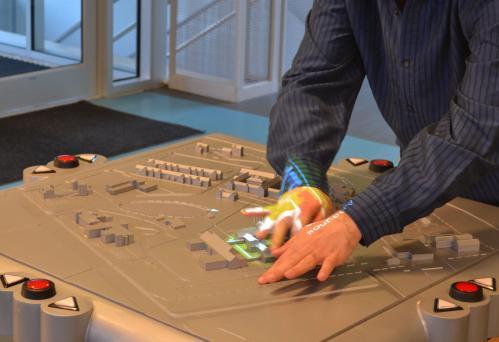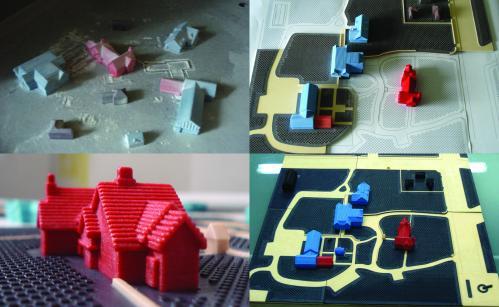 Baby, we’ve come a long way, for sure, but what about when we reach our destination? It helps me enormously to have ‘all systems go’ when I’m on the move and using my GPS, but often then it seems like a what now? scenario when approaching a venue that’s foreign and looming large. Imagine trying to navigate these daily scenarios with a visual (or other) impairment.
Baby, we’ve come a long way, for sure, but what about when we reach our destination? It helps me enormously to have ‘all systems go’ when I’m on the move and using my GPS, but often then it seems like a what now? scenario when approaching a venue that’s foreign and looming large. Imagine trying to navigate these daily scenarios with a visual (or other) impairment.
You may no longer be on your own when you hit the curb though, thanks to developers at the Center for Inclusive Design and Environmental Access (IDeA Center) at the University of Buffalo, who have used 3D printing to create tactile models for specific locations such as Perkins School for the Blind in Massachusetts, which uses conductive paint on 3D printed miniature buildings to sense pressure from a visitor’s fingers. These designs are a specialty of the IDeA Center, which is part of UB’s School of Architecture and Planning.
 In partnership with Touch Graphics, Inc., their prototype maps featuring 3D printed miniatures of structures and offices are meant to be a help to everyone, no matter what the disability or directional issue may be. The maps aren’t just utilitarian vehicles for getting from one spot to another, they are also startlingly creative, featuring delightful and high-tech details that occur upon touch like:
In partnership with Touch Graphics, Inc., their prototype maps featuring 3D printed miniatures of structures and offices are meant to be a help to everyone, no matter what the disability or directional issue may be. The maps aren’t just utilitarian vehicles for getting from one spot to another, they are also startlingly creative, featuring delightful and high-tech details that occur upon touch like:
- Fountains that gurgle
- Chiming bell towers
- Spotlights that shine on buildings
“It’s really about giving this audience, this population, a way to understand their environment,” says IDeA Center researcher Heamchand Subryan, who led the project with IDeA Center Director Edward Steinfeld, ArchD, and Touch Graphics President Steve Landau. “We’re providing a level of information that allows them to navigate their environment easily, without help, which gives them a sense of independence.”
It’s a basic need to have a good feel for where we are going, and to be able to do it as independently as possible.
“The touch-responsive models solve the ‘last mile’ problem for blind pedestrians, who can often navigate to a building or campus address using GPS, but then need help to get to the classroom building or doctor’s office where they need to be,” Landau says.
 They might be thinking outside of the box but the developers of these innovative models are also setting the world right, featuring a horizontal dynamic, rather than the traditional vertical map which hangs on a wall or is encased in a plastic kiosk at the mall. The horizontal alignment allows the user to consider what they are doing more realistically, spatially.
They might be thinking outside of the box but the developers of these innovative models are also setting the world right, featuring a horizontal dynamic, rather than the traditional vertical map which hangs on a wall or is encased in a plastic kiosk at the mall. The horizontal alignment allows the user to consider what they are doing more realistically, spatially.
There are also prototypes in Massachusetts at The Carroll Center for the Blind and The Technology Center. A prototype is in place at the Chicago Lighthouse for the Blind, where the model shows a two-story building’s floor plan. Plans to install a model are also in place for the Philadelphia-based Overbrook School for the Blind. All three projects employ universal design, which aims to produce buildings, spaces, and products accessible to all people instead of individual segments of the population.
I don’t know about you, but there have been a number of times when someone has asked me where I was and I had to consult my phone first, in all my directional impairment. We all need help in knowing how to get around foreign buildings and venues and most of us like to do that with a sense of independence.

When one sense is impaired, the others become magnified. So it also makes ‘sense’ that in creating tools for the visually impaired, we should appeal to both touch and sound, and inspire at the same time, whenever possible. With so any bright minds out there using innovative technology to make everything under the sun, the world of mapping and logistics should be brightly lit for everyone — and that’s what these scientists endeavor to provide.
Have you seen any of these 3D maps? Tell us about it in the 3D Maps by IDeA forum at 3DPB.com.
Subscribe to Our Email Newsletter
Stay up-to-date on all the latest news from the 3D printing industry and receive information and offers from third party vendors.
You May Also Like
3D Printing Unpeeled: New Arkema Material for HP, Saddle and Macro MEMS
A new Arkema material for MJF is said to reduce costs per part by up to 25% and have an 85% reusability ratio. HP 3D HR PA 12 S has been...
3D Printing News Briefs, January 20, 2024: FDM, LPBF, Underwater 3D Printer, Racing, & More
We’re starting off with a process certification in today’s 3D Printing News Briefs, and then moving on to research about solute trapping, laser powder bed fusion, and then moving on...
3D Printing Webinar and Event Roundup: December 3, 2023
We’ve got plenty of events and webinars coming up for you this week! Quickparts is having a Manufacturing Roadshow, America Makes is holding a Member Town Hall, Stratafest makes two...
Formnext 2023 Day Three: Slam Dunk
I’m high—high on trade show. I’ve met numerous new faces and reconnected with old friends, creating an absolutely wonderful atmosphere. The excitement is palpable over several emerging developments. The high...































